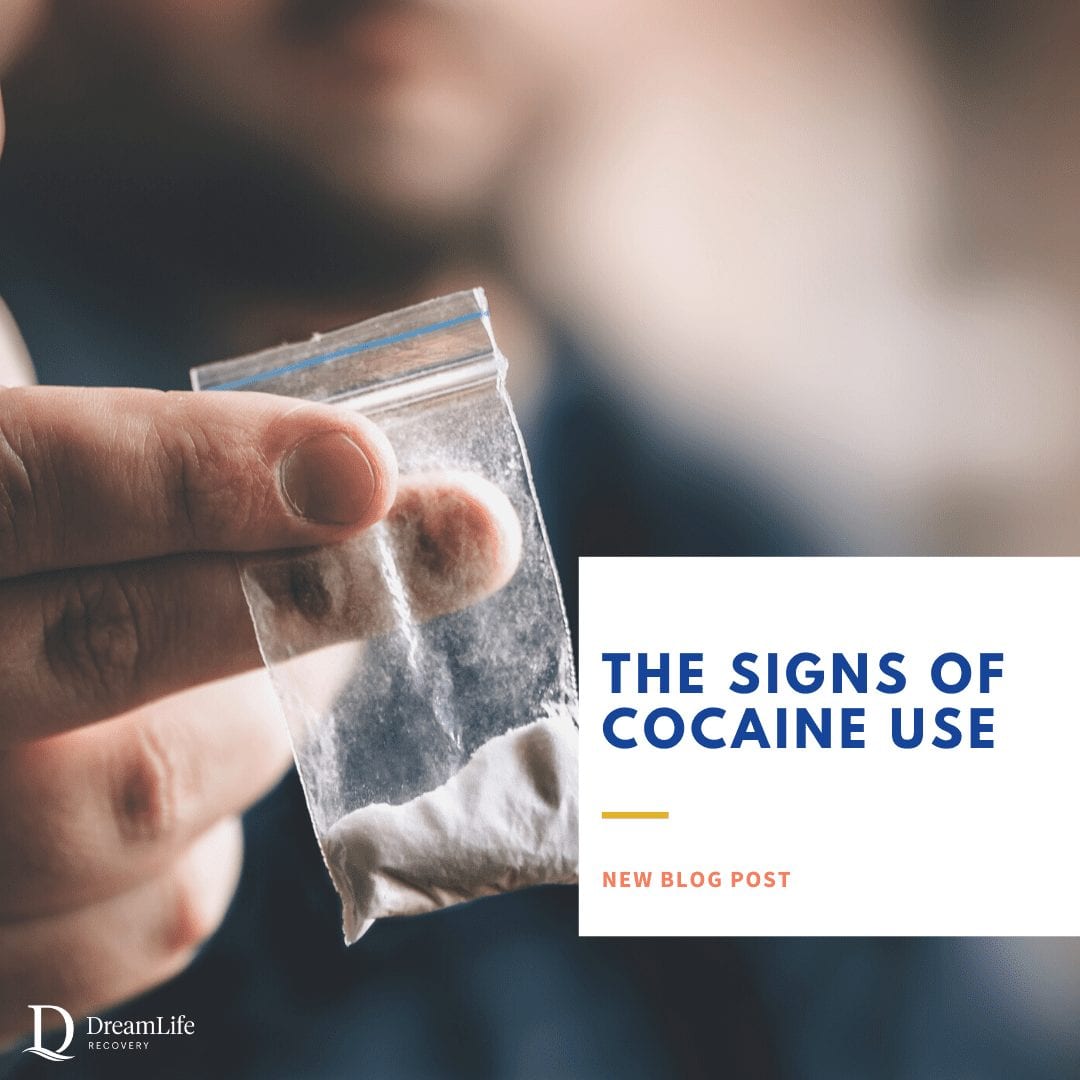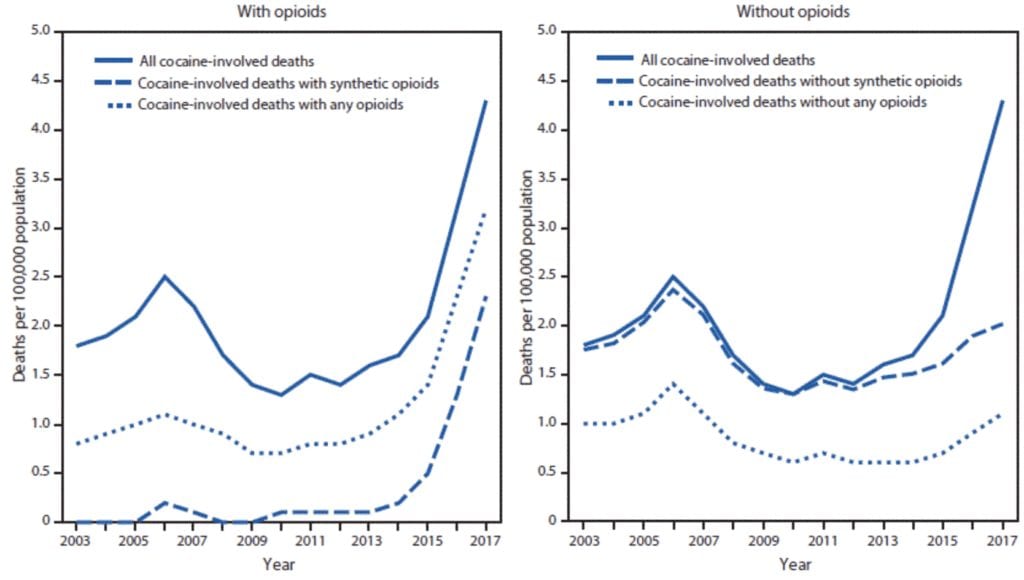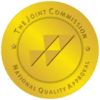The Signs of Cocaine Use

Written By
DreamLife RecoveryCocaine is a potent stimulant derived from the leaves of the coca plant that grows in South America. Often sold as a fine, white powder, cocaine is typically snorted but can be injected, ingested, or smoked (crack cocaine). Cocaine use grew in popularity in the 1980’s and became a party drug because of its euphoric effects.
Cocaine primarily affects the reward center of the brain by stimulating the release of the feel-good neurotransmitter dopamine. Although a survey by the National Institute on Drug Abuse found that 15 percent of the population has tried cocaine in the United States, it is illegal and classified as a Schedule II illicit substance by the Drug Enforcement Authority (DEA).
Given that cocaine is widely used and highly addictive, recognizing cocaine use could help prevent someone from developing a cocaine addiction. If you are concerned someone you care about may be using cocaine, there are signs of cocaine use you should know.

Common Signs of Cocaine Use
To know what signs of cocaine use you should watch for, it is helpful to understand a bit more about how it is used and its effects on users. The most common way to use cocaine is by snorting it. Once the cocaine enters the bloodstream, it goes to the brain, where it blocks the reuptake of the neurotransmitter dopamine. This causes a surge of dopamine in the brain, which is responsible for the euphoric feelings.
Snorting cocaine usually causes a high for 15 to 30 minutes, in which a person may feel more alert, energetic, and exhilarated. It decreases appetite and because it is a stimulant, can keep people awake for long periods of time.
If you are worried someone is using cocaine, there are common signs to be aware of. For example, if you notice the person frequently disappears for a short time and returns in a visibly altered mood—more excited, talkative, confident, or energetic—that is something to note. It could indicate they are going to use in private. If they are snorting cocaine, they may sniffle or touch their nose a lot.
Other short-term effects of cocaine use and signs to look for include:
- Disappearing for short periods and returning in an altered mood
- A person who is suddenly more talkative, excited, energetic, or overly confident
- Dilated pupils
- Wiping nose, powder near nose, or runny nose
- Reduced appetite
- Insomnia
In addition to these short-term effects and common signs of cocaine use, you should also be aware of other possible behavioral effects and physical symptoms that can occur either during a cocaine high or after a binge.
These can include:
- Paranoia
- Delusions/hallucinations
- Irritability or agitation
- Aggressive behavior
- Anxiety
- Depression
- Nasal issues, nosebleeds
- Stomach or digestive issues
- Sleeping for long periods (hypersomnia)
- Weight loss
- Heart arrhythmias or irregular heartbeat
A person who uses cocaine may be good at hiding these signs and masking their symptoms. However, if you are aware of the range of effects of cocaine use, you may be able to recognize the signs.
Uncommon Signs of Cocaine Use
While it is more common to snort cocaine, there are several other ways to use it that can result in uncommon signs of cocaine use. Some people will dissolve and inject cocaine rather than—or in addition to—snorting it. Others may ingest it directly, rubbing it on the gums or swallowing it. Some use suppositories to plug it rectally.
Another form of cocaine called freebase cocaine is sold as a solid, white rock. This is commonly called crack cocaine or just “crack,” which is smoked in pipe. Smoking leads to an immediate, intense and short high of about five to 10 minutes.
Considering these other methods consumption, some uncommon signs of cocaine use include:
- Track marks (injecting)
- Burns around the mouth or fingers (smoking)
- Stomach and digestive tract problems (ingestion)
- Gangrene of the bowels (ingestion)
- Anal or rectal issues (plugging)
In addition to these less common signs of cocaine use, it is important to know the signs of cocaine overdose. Signs of cocaine overdose include:
- Increased heart rate
- Spike in body temperature
- Sweating
- Tremors
- Trouble breathing
- Nausea or vomiting
- Agitation or disorientation
- Chest pains
- Convulsions
- Seizure
If you or someone you know appears to be having an overdose on cocaine, you need to call 911 or seek immediate medical attention. Cocaine overdoses could lead to heart attacks, stroke, cerebral hemorrhage, or coma, which could be life-threatening. According to the CDC, cocaine overdose deaths have been on the rise in recent years.
How to Tell if Someone’s Addiction is Getting Worse
If a person is developing a cocaine addiction, you should learn about the signs (listed above) and keep track of any signs you observe. A person spiraling into a cocaine addiction may lose weight, appear run down, have frequent nasal or digestive problems, and may have strange sleeping habits.
Their behavior may seem out of character, for example, they may be more energetic and talkative than normal or could be more irritable and aggressive. The person may be more secretive about where they go, what they do, and with whom they are spending time. In order to support their habit, they may also ask to borrow money, or cash, credit cards, and valuables may start disappearing from the house (if you live with them).
The person’s physical health may suffer because of cocaine’s impacts on the body, the lack of sleep, and the risk-taking behavior that may result while high. They may be more prone to illness and disease as a result of a weakened immune system.
Cocaine use can also cause mental illness like depression and anxiety. Knowing the signs of these mental health conditions may also help to recognize a cocaine use problem that is getting worse.
If a cocaine addiction has developed, the person may see their personal and professional lives unraveling. They may struggle in their relationships and have problems at work or school as the need to use cocaine becomes all-consuming. Dealing with serious health complications and legal troubles are also signs that their cocaine has gotten worse and may be cocaine addiction.
Getting Help
When helping someone overcome a cocaine use problem, the most important thing is to offer support and to be compassionate in your approach. Do research about cocaine use to know what signs to look for and how it affects the person.
If you are planning to talk to a friend, partner, or family member about their cocaine use, be sure to plan what you will say so that you can be more effective. Try not to let emotions derail the conversation. Focus on expressing your concern and explaining that you are worried about their health and well-being and want to help. Avoid talking to them about their cocaine use while they appear under the influence of cocaine or another substance.
If the person may be struggling with a cocaine addiction, they need professional substance abuse treatment to get better. In this situation, you should help them to find a treatment program that provides personalized care and a detox program to begin recovering from the addiction.
While cocaine is highly addictive and can cause serious health problems, anyone can recover and stop using the drug with the proper help and support. Learn more about our cocaine addiction treatment program and contact us today..
Resources:
- Research Report Series; Cocaine – National Institute on Drug Abuse
- “What is Cocaine?” – National Institute on Drug Abuse
- Cocaine Overdose – Cocaine.org
- “Drug Overdose Deaths Involving Cocaine and Psychostimulants with Abuse Potential — United States, 2003–2017” – Centers for Disease Control and Prevention; Mbabazi Kariisa, Ph.D.; Lawrence Scholl, Ph.D.; Nana Wilson, Ph.D.; Puja Seth, Ph.D.; Brooke Hoots, Ph.D.; May 3, 2019 / 68(17); 388–395






